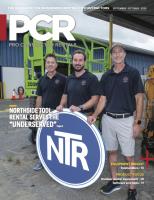Service Tips: 10-point check to hydraulic system health
Hydraulic system maintenance is a critical component to ensure your machinery stays in top working order.
Basic system maintenance can help you avoid an untimely and expensive breakdown. Here’s a quick basic checklist that maintenace staff and customers alike should folow to keep equipment hydarulic systems healthy and operating trouble-free. These tips were developed by Coastal Hydraulics, experts in hydraulic and pneumatic sales, service and repair in Charleston, South Carolina.
Any operator responsible for hydraulic system maintenance should, at minimum, perform the following 10 point checklist as part of a weekly “quick scan” of every hydraulic system.
1 Check fluid levels and add hydraulic fluid if needed. Not all hydraulic fluids are the same, so do not mix oils! Use the same oil brand and viscosity grade that is specified.
2 Inspect breather caps, breather filters and fill screens. Do not punch holes in screens to expedite adding oil. This may allow contaminants into the system.
4 Visually inspect all system hoses, pipes and pipe connections for leaks, frays, bubbling, or chaffing spots. Hydraulic fluid leakage is a common problem for industrial systems. Excessive leakage is an environmental and safety hazard, increases waste streams and oil consumption and if ignored, can reduce the system capacity enough to overheat and slow normal system operation. Further, leakage is often an indication of seal wear or other compromise associated with an impending failure.
5 Check system temperature with built-in thermometers or hand-held infrared detectors. Normal temperature range for most systems is 110F to 140F but may vary. If temperatures are high, check fluid levels, cooler operation and relief-valve settings.
6 Inspect inside the reservoir for signs of aeration by looking into the hydraulic system fill hole with flashlight. Aeration is a condition in which discrete bubbles of air are carried along in the stream of oil as it enters the pump. Signs of aeration in the reservoir are generally foaming and/or little whirlpools taking small gulps of air into the suction strainer.
Causes of aeration include low fluid levels, air leaks in the suction line, low fluid temperature, fluid too viscous to release air or maintain suction at the pump, or faulty shaft seals.
When air leaks are suspected on the suction line, smothering these points with oil will usually pinpoint the leaks by creating a marked change in pump noise. A pump ingesting air sounds as if it were gargling marbles.
7 Listen to pumps for the signs of cavitation. Cavitation is slightly more complicated than aeration, but has some similar symptoms. Cavitation occurs when air is released from the hydraulic oil during momentary depressurization at the pump suction and then implodes onto metal surfaces upon discharge.
These implosions are extremely damaging to pump surfaces. A cavitating pump will emit a high-pitched whine or scream. Causes of cavitation are the same as those of aeration with the exception of suction side air leaks.
How do you discern aeration from cavitation? One way is to install a vacuum gauge on the suction side and make sure the pressure is equal to or greater than that prescribed by the pump manufacturer. Foaming in the reservoir is usually the telltale sign of aeration.
8 Inspect a small sample of fluid for color, debris, and odor. Keep in mind that visual inspection is limited in that it will only detect signs of excess contamination.
9 Scan electrically controlled servo valves with an infrared thermometer. High valve and solenoid temperatures (more than 150F) usually indicate the valve is sticking or bypassing. Sluggish operation and violent system jerking around valves is a sign of possible contamination.
10 Scan the electric drive motor for housing hot spots and rotor bearing temperatures using an infrared thermometer. Any high temperatures mean the system should be immediately tagged out and serviced.
These basic tips will help keep your hydraulic system in top operational shape and reduce chances of untimely and expensive breakdowns.
Copyright 2019 Urbain Communications, LLC. All rights reserved. Contact curbain@urbaincomm.com for permission to reprint or rebroadcast all or part of this article.










